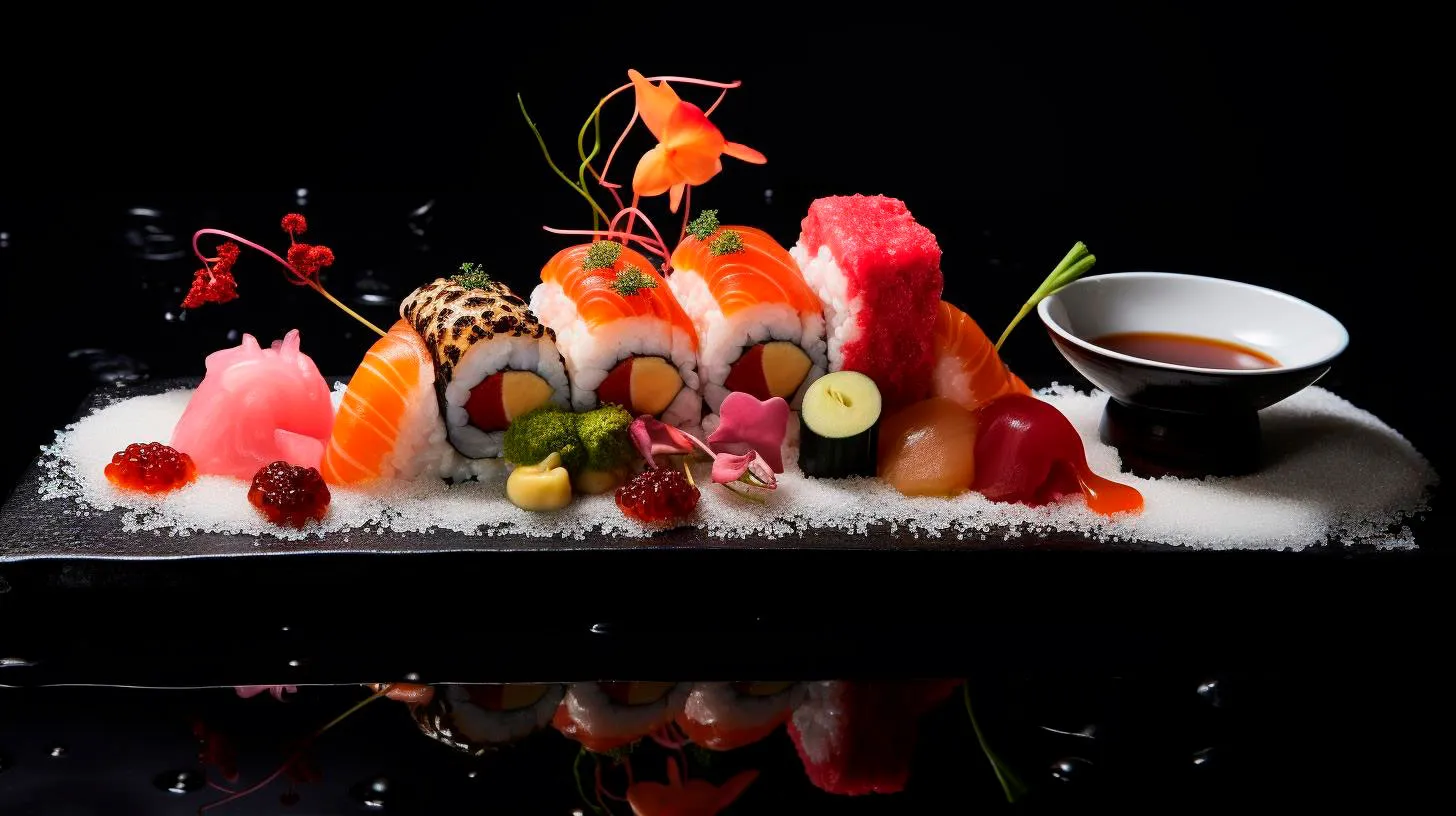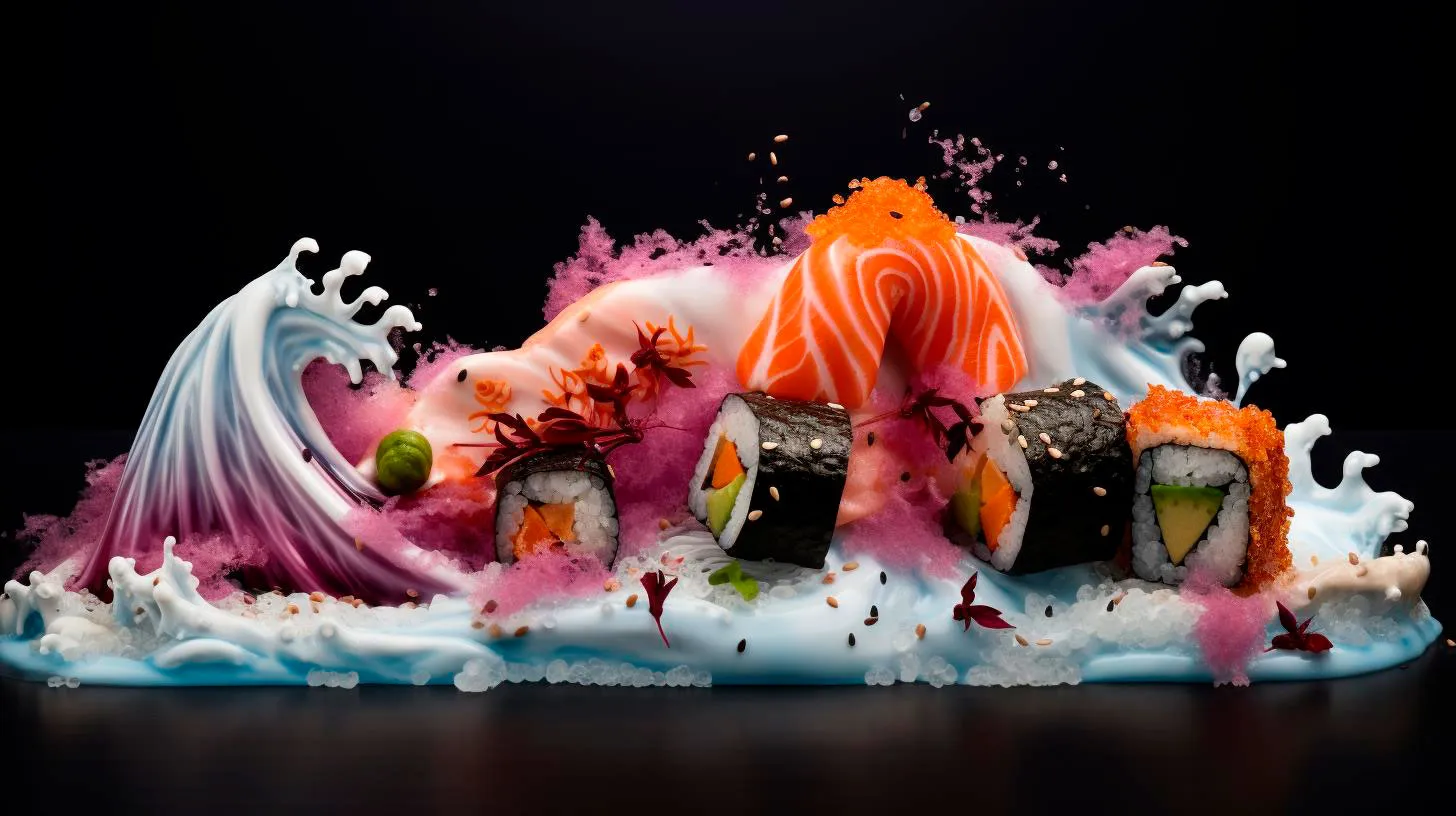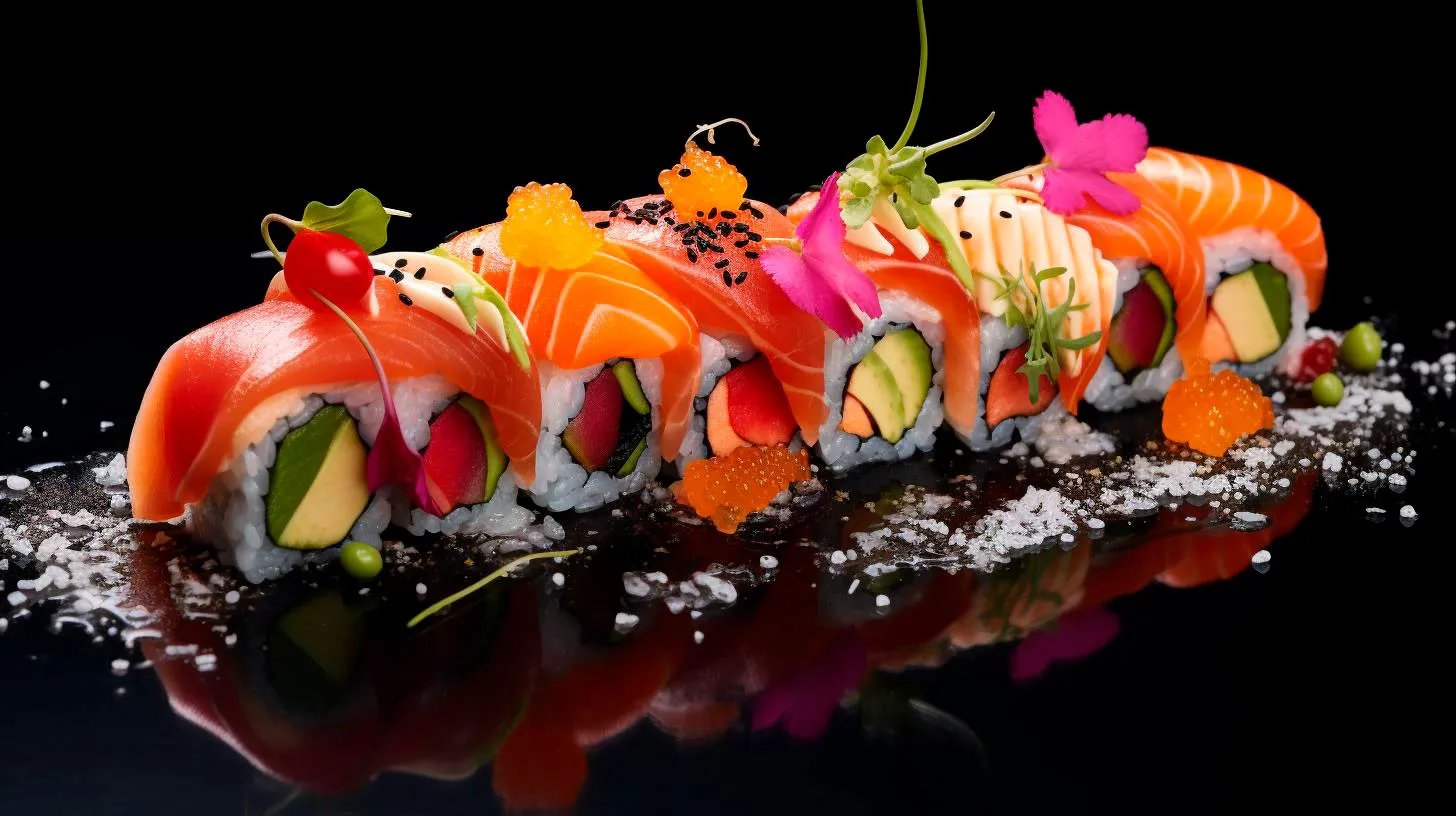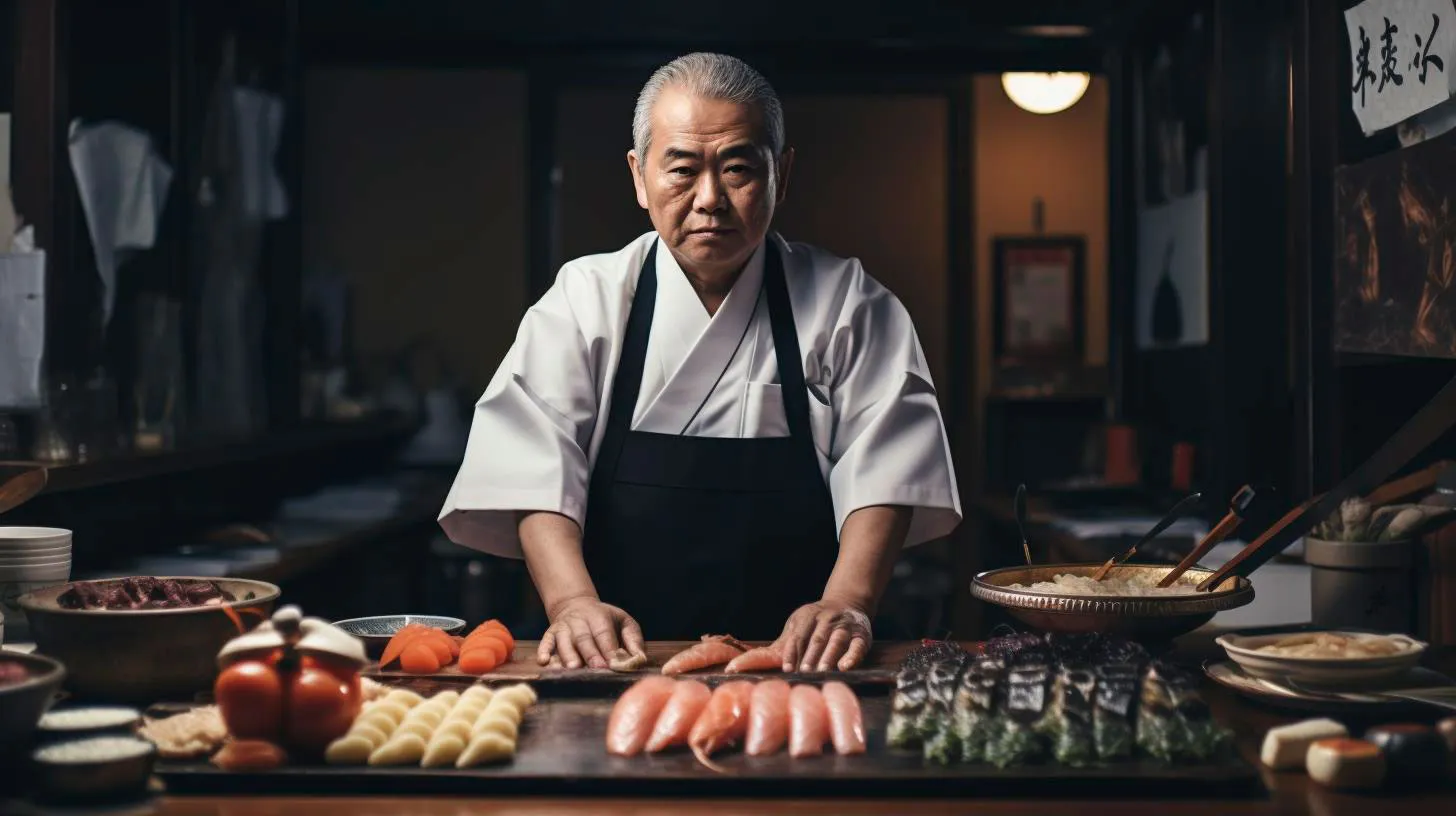Unveiling the Cultural Significance of Sushi in Japanese Celebrations
In this article, we will explore the cultural significance of sushi in Japanese festivities, shedding light on its historical roots, its role in traditional holidays, and the values it embodies.
A Brief History of Sushi
Before delving into its cultural significance, let’s take a glimpse into the intriguing history of sushi. Originating in Southeast Asia around the 4th century B.C., sushi was initially a method of preserving fish by fermenting it with rice and salt. This preservation technique eventually evolved into the more familiar form of sushi we know today, known as nigiri sushi, during the Edo period in Japan (17th to 19th century).
From its humble origins, sushi gradually gained popularity across Japan and eventually spread globally, captivating palates worldwide. Today, sushi represents not only a culinary delight but also embodies the essence of Japanese culture and traditions.
Sushi in Traditional Japanese Celebrations
Japanese celebrations are deeply rooted in cultural history and are often accompanied by traditions and customs that have been passed down through generations. Sushi plays a prominent role in several of these celebrations, symbolizing various aspects of Japanese society and values.
1. New Year’s Celebration (Oshogatsu)
Oshogatsu, the Japanese New Year, is one of the most significant and cherished celebrations in Japan. It is a time when families come together to welcome the upcoming year while honoring their heritage. Sushi, specifically osechi ryori, a traditional New Year’s meal composed of multiple dishes, holds a central place in the festivities. Each type of sushi in osechi ryori has its own symbolic meaning, representing wishes for good health, prosperity, and longevity in the coming year.
2. Cherry Blossom Viewing (Hanami) Parties
During springtime, when cherry blossoms paint Japan in vibrant hues, people gather under these blooming trees to celebrate the arrival of spring. These gatherings, known as hanami parties, are accompanied by delicious food and drinks, with sushi being a popular choice. The light and refreshing flavors of sushi perfectly complement the joyous atmosphere of hanami, making it a staple dish during these picnics.
3. Traditional Tea Ceremonies
Tea ceremonies hold immense cultural significance in Japan and are based on principles of harmony, respect, and tranquility. These ceremonies often feature a traditional meal known as kaiseki, which consists of multiple courses served in an aesthetically pleasing manner. Sushi, with its meticulous presentation and balance of flavors, is frequently included in kaiseki meals, enhancing the overall dining experience.
The Values Embodied in Sushi
Aside from its role in Japanese celebrations, sushi embodies several core values deeply ingrained in Japanese culture. These values can be reflected not only in the preparation and presentation of sushi but also in the way it is consumed and appreciated.
1. Attention to Detail
The art of sushi-making requires meticulous attention to detail. From selecting the freshest ingredients to preparing the perfect sushi rice consistency, every step is executed with precision. This attention to detail mirrors the broader Japanese cultural worldview, where precision, craftsmanship, and perfection are highly valued.
2. Simplicity and Elegance
Despite its complex preparation, sushi is emblematic of simplicity and elegance. The focus on minimal ingredients and clean flavors highlights the philosophy of simplicity often found in Japanese aesthetics and design. This simplicity extends beyond the culinary realm, influencing various aspects of Japanese culture.
3. Respect for Nature and Seasonality
Sushi chefs prioritize the use of fresh, seasonal ingredients, emphasizing their natural flavors. This respect for nature and seasonality aligns with traditional Japanese values, where the changing of seasons is celebrated and revered. By showcasing the freshest ingredients, sushi honors the bounty of nature and encourages a sustainable approach to food consumption.
Key Takeaways
Sushi goes beyond being a mere culinary delight and holds significant cultural importance in Japanese celebrations. By exploring the historical roots of sushi and its role in traditional festivities, we can appreciate the rich cultural significance it represents. The values of attention to detail, simplicity and elegance, and respect for nature embodied in sushi provide a deeper understanding of Japanese culture and its influence on the world of gastronomy.
- Sushi is an integral part of Japanese celebrations, symbolizing various aspects of Japanese society and values.
- Osechi ryori, a traditional New Year’s meal, features sushi with different symbolic meanings.
- Sushi is commonly enjoyed during cherry blossom viewing parties, known as hanami.
- Sushi is often included in traditional tea ceremonies, enhancing the overall dining experience.
- Sushi reflects values such as attention to detail, simplicity and elegance, and respect for nature and seasonality.
The Origins of Sushi: A Journey into Japanese Gastronomic Traditions
Exploring the origins of sushi allows us to understand Japan’s deep-rooted gastronomic traditions and the artistry behind this beloved cuisine. Join us on a virtual journey as we delve into the captivating story of sushi.
The Beginnings of Sushi
Sushi, in its earliest form, originated in ancient Southeast Asia, where fish was fermented with rice to preserve it. This method of preservation was necessary in regions with limited access to salt, as the rice’s natural fermentation process would prevent the fish from spoiling. The rice was discarded before consuming the fish.
Over time, this preservation technique made its way to Japan, where it evolved into what we know today as sushi. As Japan is surrounded by water teeming with marine life, it’s no surprise that seafood became the main component of sushi. This innovative culinary practice gained popularity as a fast and convenient meal for the working class in the bustling streets of Tokyo.
The Evolution of Sushi
The evolution of sushi was greatly influenced by cultural and technological advancements. In the 17th century, a notable change occurred when Hanaya Yohei, a sushi chef in Edo (now Tokyo), started using vinegar to season the rice instead of relying solely on fermentation. This technique, known as “nigiri-zushi,” marked a turning point in sushi’s history.
- Feature: Nigiri-zushi revolutionized the sushi-making process by allowing the flavors of the fish and the rice to harmonize perfectly. The inclusion of vinegar not only added a tangy punch but also acted as a natural preservative.
- Advantage: The addition of vinegar shortened the fermentation time, making sushi fresher and more accessible. This development also helped sushi gain popularity among the aristocrats and eventually spread across Japan.
As time went on, sushi continued to evolve, with different regions in Japan developing their own unique styles. In the 19th century, the birth of “makizushi” (rolled sushi) introduced the combination of seaweed, rice, and various fillings, offering a new way to enjoy sushi.
Sushi Goes Global
The 20th century witnessed the globalization of sushi, as Japanese immigrants introduced this culinary sensation to various parts of the world. Initially met with skepticism in Western countries, sushi gradually gained recognition for its artistic presentation and health benefits.
In the 1960s, the invention of the first sushi conveyor belt by Yoshiaki Shiraishi revolutionized the industry. This innovative system made sushi more accessible, allowing customers to choose their favorite dishes from a rotating selection. Today, sushi bars around the world utilize this concept to offer a unique dining experience.
- Key Takeaway: The invention of the sushi conveyor belt revolutionized the way sushi is served and consumed, making it a popular choice for casual dining.
- Industry Statistics: As of 2020, the global sushi market was valued at $13.7 billion, with a projected annual growth rate of 5.7% until 2027 (source: Allied Market Research).
Modern Sushi Trends
In recent years, sushi has continued to evolve, catering to a wide range of tastes and dietary preferences. The rise of vegetarian and vegan sushi options, incorporating ingredients like avocado, cucumber, and tofu, has made this traditional dish more inclusive.
Sustainability has also emerged as a major concern in the sushi industry. With overfishing and environmental issues, responsible sourcing and eco-friendly practices are becoming key factors for both consumers and sushi establishments. Some restaurants now focus on serving sustainable seafood to promote a healthier marine ecosystem.
- Feature: The inclusion of vegetarian and vegan options makes sushi accessible to a broader audience and promotes a plant-based lifestyle.
- Advantage: Embracing sustainable practices ensures the future availability of seafood and preserves marine biodiversity.
Furthermore, technology has made its mark on the sushi industry, with automated sushi-making machines reducing production time while maintaining consistent quality. These advancements promote efficiency and allow for higher volumes of sushi production to meet growing demands.
Celebrating Sushi’s Legacy
Today, sushi remains a beloved culinary tradition enjoyed by people around the world. Its rich history and cultural significance make it more than just a meal; it’s an art form. From traditional sushi bars to modern fusion restaurants, sushi continues to captivate food lovers with its elegance and flavor.
As we take this journey into the origins of sushi, let us appreciate the skilled hands and meticulous techniques that have shaped this gastronomic masterpiece. The story of sushi is a testament to Japan’s culinary artistry and the profound impact of food on cultural heritage.
Disclaimer: This article is intended for informational purposes only. The content is based on the author’s personal research and interpretation of the topic.
Exploring the Rich Culinary History of Japanese Holidays
This article will delve into the diverse range of traditional dishes and customs that play a vital role in Japanese holiday celebrations.
1. New Year’s Day – Osechi Ryori
Japanese New Year, or Oshogatsu, is a cherished holiday celebrated on January 1st. Osechi Ryori is the traditional meal that families prepare for this occasion. It consists of an assortment of beautifully arranged dishes, each symbolizing a specific wish for the coming year. Some popular Osechi Ryori dishes include:
- Kuromame – Sweet black soybeans representing health and a long life.
- Kazunoko – Herring roe symbolizing fertility and prosperity.
- Tazukuri – Candied sardines associated with a bountiful harvest.
- Kohaku Namasu – Marinated daikon radish and carrot representing happiness and good health.
These dishes not only offer a delicious start to the year but also serve as reminders of the hopes and wishes for the future.
2. Children’s Day – Kashiwa Mochi
Children’s Day, or Kodomo no Hi, celebrated on May 5th, is a day to honor and appreciate children. One traditional sweet enjoyed during this holiday is Kashiwa Mochi. It consists of a sticky rice cake filled with sweet red bean paste, wrapped in an oak leaf. The oak leaf represents strength, and eating Kashiwa Mochi is believed to bring good fortune and energy to children. This delightful treat is often enjoyed with green tea and is a perfect representation of the importance of family in Japanese culture.
3. Tanabata – Somen Nagashi
Tanabata, also known as the Star Festival, is celebrated on July 7th. On this day, people write their wishes on colorful strips of paper and hang them on bamboo branches. Somen Nagashi is a special dish enjoyed during Tanabata. It involves placing thin wheat noodles in a long bamboo flume filled with ice-cold water. People then catch the noodles with their chopsticks as they flow down the flume. This fun and refreshing activity add to the festive atmosphere and provides a unique way to enjoy a delightful summer meal.
4. Moon-Viewing – Tsukimi Dango
Tsukimi, or Moon-Viewing, is a traditional festival celebrated in September or October to honor the autumn moon. Tsukimi Dango, a type of sweet dumpling made from rice flour, is the iconic food for this occasion. The dumplings are often arranged in a pyramid shape, resembling the full moon. Tsukimi Dango is typically served with green tea and enjoyed while admiring the moon. This celebration reflects the appreciation of the changing seasons in Japan and the beauty of nature.
5. Christmas – Fried Chicken and Christmas Cake
Although Christmas is not a traditional Japanese holiday, it has gained popularity in recent years. Due to the influence of western culture, many Japanese families celebrate Christmas by enjoying a special meal. Fried chicken, particularly from the fast-food chain KFC, has become a popular Christmas tradition. Additionally, Christmas cake, typically a light sponge cake decorated with strawberries and whipped cream, is widely enjoyed for dessert. Japan’s unique take on Christmas cuisine showcases the country’s ability to adapt and create its own traditions.
Japanese holidays are not only a time for celebration but also a chance to explore the country’s fascinating culinary heritage. The traditional dishes associated with each holiday offer a glimpse into the values and aspirations held dear by the Japanese people. Whether it’s Osechi Ryori symbolizing hope for a prosperous new year, or Tsukimi Dango celebrating the beauty of the autumn moon, these culinary traditions add depth and meaning to Japanese holiday festivities.
So, the next time you have the opportunity to experience a Japanese holiday, be sure to savor the traditional dishes that accompany the celebrations. They not only provide a delicious culinary experience but also offer insights into the country’s rich cultural tapestry.
Diving into the Deep Flavors and Legacy of Japanese Holiday Cuisine
These festive dishes are deeply rooted in tradition and are cherished by generations, offering an intriguing blend of flavors, textures, and stories that offer a window into Japanese culture. Join us on a journey to explore the deep flavors and legacy of Japanese holiday cuisine.
An Introduction to Japanese Holiday Cuisine
In Japan, holidays are more than just a break from work or a time for celebrations; they provide an opportunity for cherished culinary experiences. Each holiday in Japan is marked by specific dishes that are prepared with meticulous attention to detail, following traditions that go back centuries.
Japanese holiday cuisine is a reflection of the country’s deep respect for nature, seasonal ingredients, and the significance of celebrating life’s milestones. Whether it’s the beautifully arranged Osechi Ryori for New Year’s Day, the colorful and joyful Hinamatsuri dolls during Girl’s Day, or the soul-warming Zoni soup to mark the beginning of the year, these dishes are a testament to Japan’s rich cultural heritage and culinary prowess.
Delving into the Flavors and Tradition
Osechi Ryori: Welcoming the New Year
Osechi Ryori is undoubtedly the most revered of all Japanese holiday cuisines. It consists of a beautifully crafted assortment of dishes, elegantly arranged in lacquered Jubako (tiered boxes). These dishes not only tantalize the taste buds but also represent a wish for health, happiness, and prosperity in the coming year. Some key highlights of Osechi Ryori include:
- Kuromame: Sweet black soybeans symbolize good health and a long life.
- Kazunoko: Herring roe is associated with fertility and having many children.
- Kinton: Mashed sweet potatoes symbolize wealth and prosperity.
Hinamatsuri: Celebrating Girls’ Day
Hinamatsuri, also known as Doll’s Day or Girls’ Day, is a time to celebrate and pray for the well-being and growth of girls. Special foods are prepared and displayed on a tiered platform adorned with intricately dressed dolls. Some must-try dishes during Hinamatsuri include:
- Chirashi Sushi: Colorful sushi rice mixed with various ingredients and topped with vibrant garnishes.
- Hishi Mochi: Diamond-shaped rice cakes flavored with kinako (roasted soybean flour) and layered with sweet bean paste.
- Strawberry Daifuku: Soft mochi stuffed with fresh strawberries and red bean paste.
Kadomatsu: Embracing the New Year’s Spirit
The Japanese New Year celebration extends beyond food, and Kadomatsu plays a significant role in honoring ancestral spirits. Kadomatsu are traditional decorations made from bamboo and pine branches, which are believed to invite good luck and prosperity. Traditional dishes like Zoni, a soup made with mochi rice cakes, vegetables, and clear broth, are prepared and shared with loved ones during this time.
The Key Takeaway
Japanese holiday cuisine offers an enchanting blend of flavors, aesthetics, and tradition. Delving into these dishes allows us to not only satisfy our taste buds but also gain insight into Japan’s deep cultural heritage. From the meticulously arranged Osechi Ryori to the vibrant dishes served during Hinamatsuri, each holiday dish tells a story and provides a snapshot of Japanese tradition and values.
So, next time you have the opportunity to experience Japanese holiday cuisine, embrace the chance to dive into this world of deep flavors and legacy. Allow yourself to be transported to a place where culinary artistry meets tradition, unlocking a truly unforgettable gastronomic adventure.



